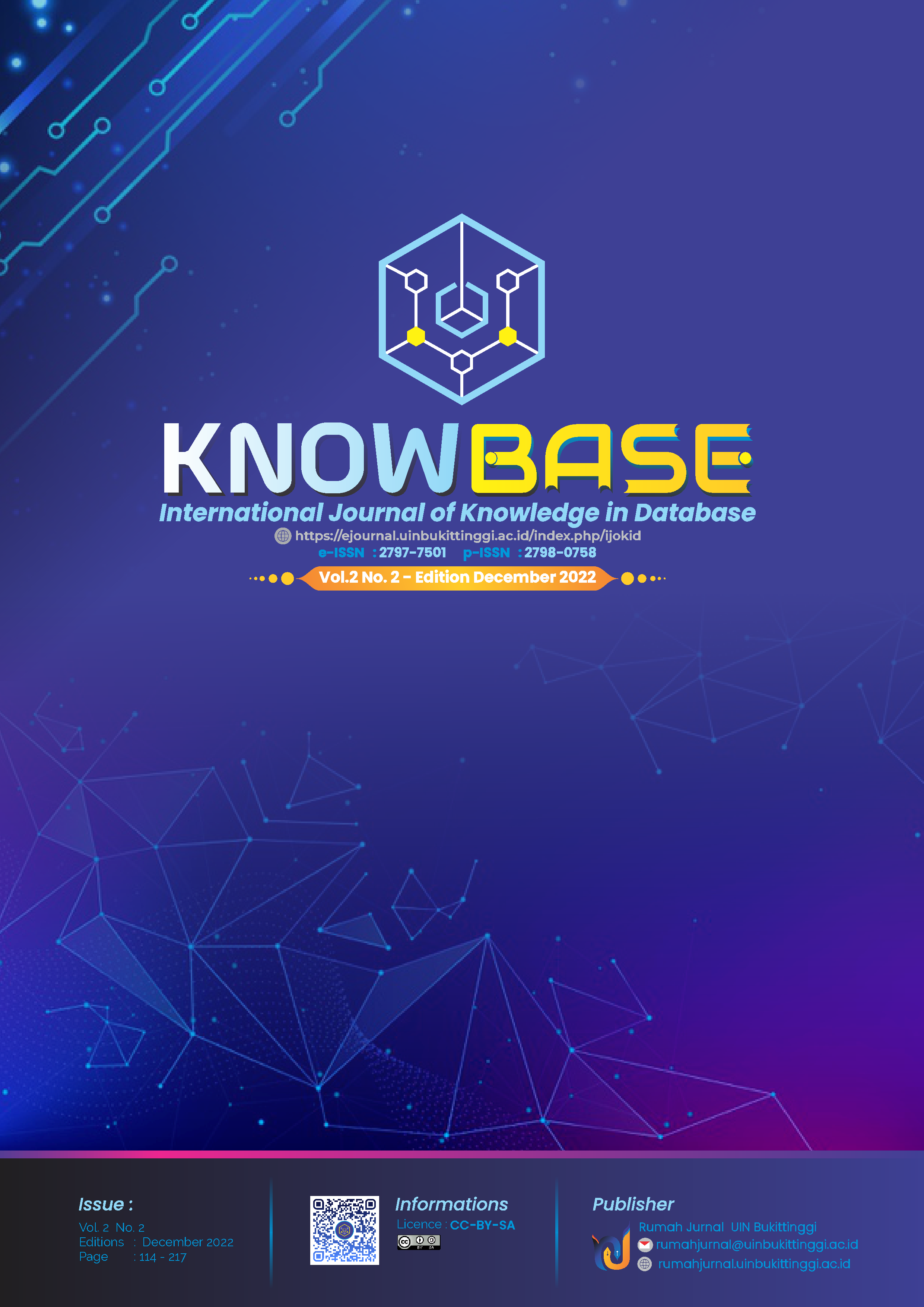Application of Case Based Reasoning Using The K-Nearest Neighbor Algorithm in an Expert System for Diagnosing Pests and Diseases of Sugarcane Plants
DOI:
https://doi.org/10.30983/knowbase.v2i2.5959Keywords:
Case Based Reasoning, KNN, Disease, SugarcaneAbstract
Sugarcane pests and diseases are still diagnosed manually, which can lead to errors such as data loss or inaccurate data. The goal of this research is to develop an expert system for identifying plant pests and diseases that affect sugarcane yield and quality. This data was obtained through literature study, observation, and interviews. The Case Based Reasoning method is used to find cases by comparing previous cases with recent cases using similarity calculations with the K-Nearest Neighbor algorithm to find the best solution from the identified cases. The results of this study indicate that the expert system for diagnosing sugarcane pests and diseases is easy to use, the appearance is easy to reach, and the diagnostic process does not take a long time. Based on testing the accuracy of the system to diagnose according to the expert's mind, it got an accuracy of 96% from 50 cases tested with the system and got a percentage result of 87.33% from 10 respondents including very feasible criteria.
References
M. W. Astuti, H. A. Mumtahana, and R. Pamungkas, “Aplikasi Monitoring Kinerja" WORM-APP" untuk Dosen dan Karyawan (Studi Kasus: Universitas PGRI Madium),†J. IT, vol. 12, no. 2, pp. 78–89, 2021.
H. Suyono, “Belajar dan pembelajaran,†Bandung: Remaja Rosdakarya, 2011.
I. Khasanah, G. Raynanda, and P. R. A. Adhi, “Penerapan Metode Extreme Programming untuk Membangun Sistem Monitoring Lembaga Penelitian dan Pengabdian Masyarakat Palcomtech,†vol. 12, no. 02, pp. 175–186, 2022.
Q. Lu, U. Hasson, and K. A. Norman, “A neural network model of when to retrieve and encode episodic memories,†Elife, vol. 11, p. e74445, 2022.
T.-D. Bui, J.-W. Tseng, M.-L. Tseng, and M. K. Lim, “Opportunities and challenges for solid waste reuse and recycling in emerging economies: A hybrid analysis,†Resour. Conserv. Recycl., vol. 177, p. 105968, 2022.
A. Wang et al., “REVISE: A tool for measuring and mitigating bias in visual datasets,†Int. J. Comput. Vis., pp. 1–21, 2022.
A. Korsunova, M. Halme, A. Kourula, J. Levänen, and M. Lima-Toivanen, “Necessity-driven circular economy in low-income contexts: How informal sector practices retain value for circularity,†Glob. Environ. Chang., vol. 76, p. 102573, 2022.
M. Arifin, F. Ariyana, and A. Widodo, “Testing of Integrated Sales Information Systems On UD. Remaja Bumi Raya Based on Black Box Testing with Equivalence Partitioning Method,†J. Softw. Eng. Ampera, vol. 3, no. 2, pp. 74–83, 2022.
D. Marijan and C. Lal, “Blockchain verification and validation: Techniques, challenges, and research directions,†Comput. Sci. Rev., vol. 45, p. 100492, 2022.
D. J. Weeks and F. Leite, “Minimizing facility corrective maintenance: Benchmarking preventative-to-corrective maintenance ratios using maintenance data and building age in dormitories,†J. Manag. Eng., vol. 38, no. 1, p. 4021086, 2022.
J.-F. Zhang et al., “A Trade-Off for Maintenance of Multidrug-Resistant IncHI2 Plasmids in Salmonella enterica Serovar Typhimurium through Adaptive Evolution,†Msystems, pp. e00248-22, 2022.
Downloads
Additional Files
Published
How to Cite
Issue
Section
Citation Check
License
Copyright (c) 2024 Andi Maulidinnawati A K P

This work is licensed under a Creative Commons Attribution-ShareAlike 4.0 International License.
Authors who publish with this journal agree to the following terms:
- Authors retain copyright and grant the journal right of first publication with the work simultaneously licensed under a Creative Commons Attribution License that allows others to share the work with an acknowledgment of the work's authorship and initial publication in this journal.
- Authors are able to enter into separate, additional contractual arrangements for the non-exclusive distribution of the journal's published version of the work (e.g., post it to an institutional repository or publish it in a book), with an acknowledgment of its initial publication in this journal.
- Authors are permitted and encouraged to post their work online (e.g., in institutional repositories or on their website) prior to and during the submission process, as it can lead to productive exchanges, as well as earlier and greater citation of published work (See The Effect of Open Access).




